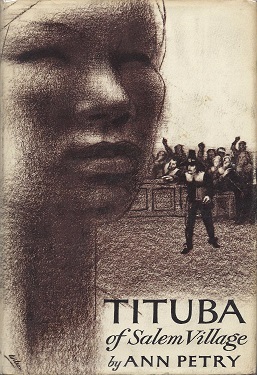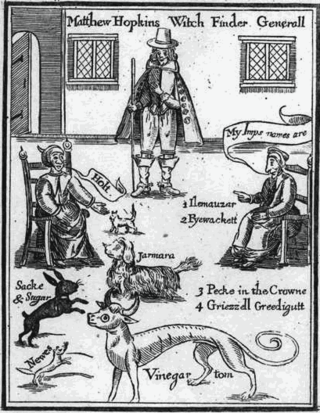Related Research Articles

The Salem witch trials were a series of hearings and prosecutions of people accused of witchcraft in colonial Massachusetts between February 1692 and May 1693. More than 200 people were accused. Thirty people were found guilty, nineteen of whom were executed by hanging. One other man, Giles Corey, died under torture after refusing to enter a plea, and at least five people died in jail.
Elizabeth "Betty" Parris was one of the young girls who accused other people of being witches during the Salem witch trials. The accusations made by Parris and her cousin Abigail Williams caused the direct death of 20 Salem residents: 19 were hanged, while another, Giles Corey, was pressed to death.

Bridget Bishop was the first person executed for witchcraft during the Salem witch trials in 1692. Nineteen were hanged, and one, Giles Corey, was pressed to death. Altogether, about 200 people were tried.
Jane Wenham was one of the last people to be condemned to death for witchcraft in England, although her conviction was set aside. Her trial in 1712 is commonly but erroneously regarded as the last witch trial in England.

Goody Ann Glover was an Irish former indentured servant and the last person to be hanged in Boston as a witch, although the Salem witch trials in nearby Salem, Massachusetts, occurred mainly in 1692.

Wilmot Redd was one of the victims of the Salem witch trials of 1692. She was born in Marblehead, Massachusetts, and executed by hanging on September 22, 1692. Her husband was Samuel Redd, a fisherman. She was known for her irritability, but she was given little serious attention.
Petronilla de Meath was the maidservant of Dame Alice Kyteler, a Hiberno-Norman noblewoman who lived in Ireland in what is now County Kilkenny. After the death of Kyteler's fourth husband, Kyteler was accused of practicing witchcraft and Petronilla was charged with being one of her accomplices. Petronilla was tortured and forced to proclaim that she and Kyteler were guilty of witchcraft. Kyteler fled to save her life, and Petronilla was then flogged and eventually burnt at the stake on 3 November 1324, in Kilkenny. Hers was the first known case in Ireland or Great Britain of death by fire for the crime of heresy.

The Bideford witch trial resulted in hangings for witchcraft in England. Temperance Lloyd, Mary Trembles and Susannah Edwards from the town of Bideford in Devon were tried in 1682 at the Exeter Assizes at Rougemont Castle. Much of the evidence against them was hearsay, although there was a confession by Lloyd, which she did not fully recant even with her execution imminent. These women have been labelled as the last witches to be hanged in England, but there are subsequent cases which are not as well documented.

Thomas Ady was an English physician and humanist who was the author of two sceptical books on witchcraft and witch-hunting.

Susannah Martin was one of fourteen women executed for the suspicion of practicing witchcraft during the Salem witch trials of colonial Massachusetts.
Christence (Christenze) Akselsdatter Kruckow was a Danish noblewoman who was executed for witchcraft after having been accused twice. She is one of the most well known victims of the witch hunt in Denmark, and one of few members of the nobility to have been executed for sorcery in Scandinavia, and the only one in Denmark.

The Northamptonshire witch trials mainly refer to five executions carried out on 22 July 1612 at Abington Gallows, Northampton. In 1612 at the Lent Assizes held in Northampton Castle a number of women and a man were tried for witchcraft of various kinds, from murder to bewitching of pigs. There are two main accounts of these witches being tried. However they differ on how many witches were tried, who they were and exactly what they were supposed to have done.
Elizabeth Howe was one of the accused in the Salem witch trials. She was found guilty and executed on July 19, 1692.

The trials of the Pendle witches in 1612 are among the most famous witch trials in English history, and some of the best recorded of the 17th century. The twelve accused lived in the area surrounding Pendle Hill in Lancashire, and were charged with the murders of ten people by the use of witchcraft. All but two were tried at Lancaster Assizes on 18–19 August 1612, along with the Samlesbury witches and others, in a series of trials that have become known as the Lancashire witch trials. One was tried at York Assizes on 27 July 1612, and another died in prison. Of the eleven who went to trial – nine women and two men – ten were found guilty and executed by hanging; one was found not guilty.

Tituba of Salem Village is a 1964 children's novel by African-American writer Ann Petry about the 17th-century West Indian slave of the same name who was the first to be accused of practicing witchcraft during the 1692 Salem witch trials. Written for children 10 and up, it portrays Tituba as a black West Indian woman who tells stories about life in Barbados to the village girls. These stories are mingled with existing superstitions and half-remembered pagan beliefs on the part of Puritans, and the witchcraft hysteria is partly attributed to a sort of cabin fever during a particularly bitter winter. Petry's portrayal of the helplessness of women in that period, particularly slaves and indentured servants, is key to understanding her view of the Tituba legend.

Sarah Bibber was involved in the infamous Salem witch trials in 1692, both as an accuser of witchcraft, as well as being accused of being a witch herself.
Witch trials and witch related accusations were at a high during the early modern period in Britain, a time that spanned from the beginning of the 16th century to the end of the 18th century.

In England, witch trials were conducted from the 15th century until the 18th century. They are estimated to have resulted in the death of perhaps 500 people, 90 percent of whom were women. The witch hunt was at its most intense stage during the English Civil War (1642–1651) and the Puritan era of the mid-17th century.

The Windsor Witches was the common name for a witch trial in Windsor and Abingdon in England in 1579. The name referred to the four women tried and executed for sorcery: the cunning woman Mother Elizabeth Stile, Mother Devell, Mother Dutten and Mother Margaret.
Anne Kerke or Anne Kirk, was an English woman executed for witchcraft.
References
- 1 2 The Most Strange and Admirable Discouerie of the Three Witches of Warboys Arraigned, Conuicted, and Executed at the Last Assises at Huntington, for the Bewitching of the Fiue Daughters of Robert Throckmorton Esquire, and Other Persons (1593), Reprint. BiblioBazaar. 2010.
- ↑ Notestein, Wallace (1911). A history of witchcraft in England from 1558 to 1718. Washington DC: The American historical association. p. 47.
- ↑ Hutchinson, Francis, An Historical Essay Concerning Witchcraft, Chap. VII, The Witches of Warbois, London, 1718.
- 1 2 Anonymous (1593). The most strange and admirable discouerie of the three Witches of Warboys. London.
- ↑ Anonymous (1593). The most strange and admirable discovery of the three Witches of Warboys. London.
- 1 2 Matin, Luke (16 December 2018). "The Witch Trials – Witches of Warboys Witch Trials". Luke Matin.
- ↑ Purkiss, Diane (2013). The Witch in History: Early Modern and Twentieth-Century Representations. Routledge. p. 135.
- ↑ Kermode, J.I.; Walker, Garthine (1994). Women, crime and the courts in early modern England. London: UCL Press. ISBN 1857281403.
- ↑ Jordan, William Chester (2002). Creager, Angela N.H. (ed.). The animal-human boundary: historical perspectives. Rochester, N.Y: University of Rochester Press. p. 178. ISBN 9781580461207.
- ↑ Words like daggers: violent female speech in early modern England. [S.l.]: University of Nebraska Press. 2015. p. 92. ISBN 978-0-8032-5488-6.
- ↑ Picknett, Lynn (2005). The secret history of Lucifer: the ancient path to knowledge and the real Da Vinci code (Paperback ed.). London: Robinson. ISBN 978-1845292638.
- ↑ DeWindt, Anne (1995). "Witchcraft and Conflicting Visions of the Ideal Village Community". Journal of British Studies. 34 (4): 427–463. doi:10.1086/386086. S2CID 146412487. JSTOR. Web. 5 November 2014.
- ↑ "Weird Sister". Kate Pullinger. Retrieved 12 February 2019.